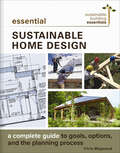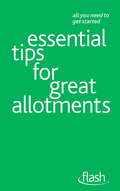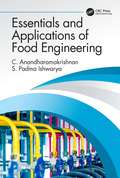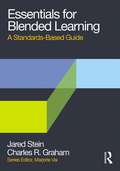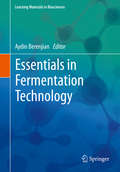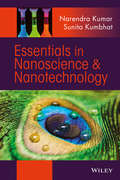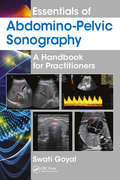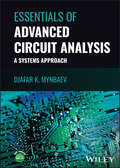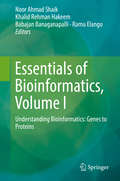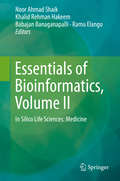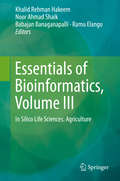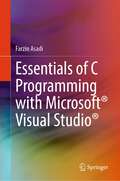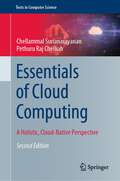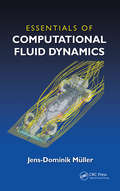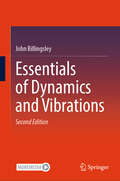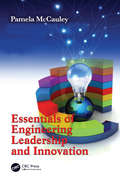- Table View
- List View
Essential SQA Exam Practice: National 5 Computing Science Questions and Papers
by Lesley RussellExam board: SQALevel: National 5Subject: Computing ScienceFirst teaching: August 2017First exam: Summer 2018Practice makes permanent. Feel confident and prepared for the SQA National 5 Computing Science exam with this two-in-one book, containing practice questions for every topic, plus two full practice papers - all written by an experienced examiner.> Choose which topics you want to revise: A simple grid enables you to pick particular areas of the course that you want to answer questions on, with solutions provided at the back of the book> Remember more in your exam: Repeated and extended practice will give you a secure knowledge of the key areas of the course (software design and development; computer systems; database design and development; web design and development)> Familiarise yourself with the exam paper: Both practice papers mirror the language and layout of the real SQA papers; complete them in timed, exam-style conditions to increase your confidence before the exams> Find out how to achieve a better grade: Answers to the practice papers have commentaries for each question, with tips on writing successful answers and avoiding common mistakesFully up to date with SQA's requirementsThe questions, mark schemes and guidance in this practice book match the requirements of the revised SQA National 5 Computing Science specification for examination from 2018 onwards.
Essential SQA Exam Practice: National 5 Computing Science Questions and Papers
by Lesley RussellExam board: SQALevel: National 5Subject: Computing ScienceFirst teaching: August 2017First exam: Summer 2018Practice makes permanent. Feel confident and prepared for the SQA National 5 Computing Science exam with this two-in-one book, containing practice questions for every topic, plus two full practice papers - all written by an experienced examiner.> Choose which topics you want to revise: A simple grid enables you to pick particular areas of the course that you want to answer questions on, with solutions provided at the back of the book> Remember more in your exam: Repeated and extended practice will give you a secure knowledge of the key areas of the course (software design and development; computer systems; database design and development; web design and development)> Familiarise yourself with the exam paper: Both practice papers mirror the language and layout of the real SQA papers; complete them in timed, exam-style conditions to increase your confidence before the exams> Find out how to achieve a better grade: Answers to the practice papers have commentaries for each question, with tips on writing successful answers and avoiding common mistakesFully up to date with SQA's requirementsThe questions, mark schemes and guidance in this practice book match the requirements of the revised SQA National 5 Computing Science specification for examination from 2018 onwards.
Essential Statistical Concepts for the Quality Professional
by D. H. StamatisThe essence of any root cause analysis in our modern quality thinking is to go beyond the actual problem. This means not only do we have to fix the problem at hand but we also have to identify why the failure occurred and what was the opportunity to apply the appropriate knowledge to avoid the problem in the future. Essential Statistical Concepts f
Essential Sustainable Home Design: A Complete Guide to Goals, Options, and the Planning Process (Sustainable Building Essentials)
by Chris MagwoodDesign your own sustainable home Many people dream of building a beautiful, environmentally friendly home. But until now there has been no systematic guide to help potential builders work through the complete process of imagining, planning, designing, and building their ideal, sustainable home. Essential Sustainable Home Design walks potential homebuilders through the process starting with key concepts, principles, and a project vision that will guide the house to completion.Coverage includes:How to clarify your ideas and create a practical pathway to achieving your dreamA criteria matrix to guide design, material, and systems decisionsCreating a strong, integrated design team and working with professionals and code officials to keep the project on track from start to finish.Key building science concepts that make for a high-performance, durable buildingPrimer on building logistics, material sourcing, and protocols to ensure that the initial vision for the project comes to fruition.One-page summaries and ratings of popular sustainable building materials and system options.Ideal for owner-builders and sustainable building contractors working with clients aiming to design and build a sustainable home. Chris Magwood has designed and built some of the most innovative, sustainable buildings in North America, including the first off-grid, straw bale home in Ontario. He is co-founder and director the Endeavour Centre for Innovative Building and Living and co-editor of the Sustainable Building Essentials series. Chris is the author of Essential Prefab Straw Bale Construction, Essential Hempcrete Construction, Straw Bale Details, More Straw Bale Building , and Making Better Buildings .
Essential Tips for Great Allotments: Flash
by Geoff StokesThe books in this bite-sized new series contain no complicated techniques or tricky materials, making them ideal for the busy, the time-pressured or the merely curious. Essential Tips for Great Allotments: Flash is a short, simple and to-the-point guide that will teach you all the fundamentals for your allotment, from what tools to use to which crops to grow in just 96 pages. For those new to allotments, this is an ideal starting point for growing your own produce organically.
Essential US for Trauma: E-FAST
by Mauro ZagoE-FAST (extended focused assessment by sonograpy for trauma) represents the basic ultrasonographic approach to any trauma patient. Identification or exclusion of free fluid and air in the abdominal and thoracic cavities plays a pivotal role in deciding the immediate diagnostic and therapeutic path. Learning E-FAST is mandatory for all acute care surgeons and all physicians involved in trauma management. The structure of the book and its practical approach will make it an easy-to-consult and quick reference tool for beginners and a useful support for more experienced professionals.
The Essential Writings of Vannevar Bush
by Vannevar BushThe influence of Vannevar Bush on the history and institutions of twentieth-century American science and technology is staggeringly vast. As a leading figure in the creation of the National Science Foundation, the organizer of the Manhattan Project, and an adviser to Presidents Roosevelt and Truman during and after World War II, he played an indispensable role in the mobilization of scientific innovation for a changing world. A polymath, Bush was a cofounder of Raytheon, a pioneer of computing technology, and a visionary who foresaw the personal computer and might have coined the term “web.”Edited by Bush’s biographer, G. Pascal Zachary, this collection presents more than fifty of Bush’s most important works across four decades. His subjects are as varied as his professional pursuits. Here are his thoughts on the management of innovation, the politics of science, research and national security, technology in public life, and the relationship of scientific advancement to human flourishing. It includes his landmark introduction to Science, the Endless Frontier, the blueprint for how government should support research and development, and much more. The works are as illuminating as they are prescient, from considerations of civil-military relations and the perils of the nuclear arms race to future encyclopedias and information overload, the Apollo program, and computing and consciousness. Together, these pieces reveal Bush as a major figure in the history of science, computerization, and technological development and a prophet of the information age.
Essentials and Applications of Food Engineering
by C. Anandharamakrishnan S. Padma IshwaryaEssentials & Applications of Food Engineering provides a comprehensive understanding of food engineering operations and their practical and industrial utility. It presents pertinent case studies, solved numerical problems, and multiple choice questions in each chapter and serves as a ready reference for classroom teaching and exam preparations. The first part of this textbook contains the introductory topics on units and dimensions, material balance, energy balance, and fluid flow. The second part deals with the theory and applications of heat and mass transfer, psychrometry, and reaction kinetics. The subsequent chapters of the book present the heat and mass transfer operations such as evaporation, drying, refrigeration, freezing, mixing, and separation. The final section focuses on the thermal, non-thermal, and nanotechnology-based novel food processing techniques, 3D food printing, active and intelligent food packaging, and fundamentals of CFD modeling. Features Features 28 case studies to provide a substantial understanding of the practical and industrial applications of various food engineering operations Includes 178 solved numerical problems and 285 multiple choice questions Highlights the application of mass balance in food product traceability and the importance of viscosity measurement in a variety of food products Provides updated information on novel food processing techniques such as cold plasma, 3D food printing, nanospray drying, electrospraying, and electrospinning The textbook is designed for undergraduate and graduate students pursuing Food Technology and Food Process Engineering courses. This book would also be of interest to course instructors and food industry professionals.
Essentials for Blended Learning: A Standards-Based Guide (Essentials of Online Learning)
by Jared Stein Charles R. GrahamEssentials for Blended Learning: A Standards-Based Guide provides a practical, streamlined approach for creating effective learning experiences by blending online activities and the best of face-to-face teaching. This guide is: Easy to use: Clear, jargon-free writing; illustrations; and references to online resources help readers understand concepts. Streamlined: A simple but effective design process focuses on creating manageable activities for the right environment. Practical: Real-world examples from different subject areas help teachers understand principles in context. Contemporary: The variety of modern, connected technologies covered in the guide addresses a range of teaching challenges. Forward-Looking: The approach bridges the gap between formal classroom learning and informal lifelong learning. Standards-based: Guidelines and standards are based on current research in the field, relevant learning theories, and practitioner experiences. Effective blended learning requires significant rethinking of teaching practices and a fundamental redesign of course structure. Essentials for Blended Learning: A Standards-Based Guide simplifies these difficult challenges without neglecting important opportunities to transform teaching. This guide is suitable for teachers in any content area. Please visit www.essentialsforblended.com for additional resources.
Essentials in Fermentation Technology (Learning Materials in Biosciences)
by Aydin BerenjianThis textbook teaches the principles and applications of fermentation technology, bioreactors, bioprocess variables and their measurement, key product separation and purification techniques as well as bioprocess economics in an easy to understand way. The multidisciplinary science of fermentation applies scientific and engineering principles to living organisms or their useful components to produce products and services beneficial for our society. Successful exploitation of fermentation technology involves knowledge of microbiology and engineering. Thus the book serves as a must-have guide for undergraduates and graduate students interested in Biochemical Engineering and Microbial Biotechnology
Essentials in Nanoscience and Nanotechnology
by Narendra Kumar Sunita KumbhatThis book describes various aspects of nanoscience and nanotechnology. It begins with an introduction to nanoscience and nanotechnology and includes a historical prospective, nanotechnology working in nature, man -made nanomaterial and impact of nanotechnology illustrated with examples. It goes on to describes general synthetic approaches and strategies and also deals with the characterization of nanomaterial using modern tools and techniques to give basic understanding to those interested in learning this emerging area. It then deals with different kinds of nanomaterial such as inorganics, carbon based-, nanocomposites and self-assembled/supramolecular nano structures in terms of their varieties, synthesis, properties etc. In addition, it contains chapters devoted to unique properties with mathematical treatment wherever applicable and the novel applications dealing with information technology, pollution control (environment, water), energy, nanomedicine, healthcare, consumer goods etc.
Essentials of Abdomino-Pelvic Sonography: A Handbook for Practitioners
by Swati GoyalSonography has emerged as a substantial diagnostic tool today. This handbook aims to cover ultrasound physics, abdominal and obstetric sonography, color Doppler, high resolution sonography and USG guided interventions with multiple choice questions and case reports for practical orientation.
Essentials of Advanced Circuit Analysis: A Systems Approach
by Djafar K. MynbaevESSENTIALS OF ADVANCED CIRCUIT ANALYSIS Comprehensive textbook answering questions regarding the Advanced Circuit Analysis subject, including its theory, experiment, and role in modern and future technology Essentials of Advanced Circuit Analysis focuses on fundamentals with the balance of a systems theoretical approach and current technological issues. The book aims to achieve harmony between simplicity, engineering practicality, and perceptivity in the material presentation. Each chapter presents its material on various levels of technological and mathematical difficulty, broadening the potential readership and making the book suitable for both engineering and engineering technology curricula. Essentials of Advanced Circuit Analysis is an instrument that will introduce our readers to real-life engineering problems—why they crop up and how they are solved. The text explains the need for a specific task, shows the possible approaches to meeting the challenge, discusses the proper method to pursue, finds the solution to the problem, and reviews the solution's correctness, the options of its obtaining, and the limitations of the methods and the results. Essentials of Advanced Circuit Analysis covers sample topics such as: Traditional circuit analysis's methods and techniques, concentrating on the advanced circuit analysis in the time domain and frequency domain Application of differential equations for finding circuits’ transient responses in the time domain, and classical solution (integration) of circuit’s differential equation, including the use of the convolution integral Laplace and Fourier transforms as the main modern methods of advanced circuit analysis in the frequency domain Essentials of Advanced Circuit Analysis is an ideal textbook and can be assigned for electronics, signals and systems, control theory, and spectral analysis courses. It’s also valuable to industrial engineers who want to brush up on a specific advanced circuit analysis topic.
Essentials of Aquaculture Practices
by Norfazreena Mohd Faudzi Muhammad Dawood Shah Nurzafirah Mazlan Sitti Raehanah Muhamad ShalehAquaculture is expanding along with the increase in demand for animal protein and hence significantly contributes to food security and socioeconomic livelihood. This book gathers current principles of aquaculture that are applied and practiced globally. It covers crucial topics including site selection, breeding and husbandry techniques, nutrition, health management, biosecurity, and sustainability. Furthermore, aquaculture's impact on food production and the economic values generated by the industry are also explored. While emphasizing the significance of environmental sustainability, this book encourages practices that minimize negative impacts on the ecosystem and preserve the health of our oceans. As a collection of reviews on the current practices in aquaculture, this book is a resource for individuals working in or interested in the industry. It also serves as a reference and guideline for students, researchers, and aquaculture operators.
Essentials of Bioinformatics, Volume I: Understanding Bioinformatics: Genes to Proteins
by Noor Ahmad Shaik Khalid Rehman Hakeem Babajan Banaganapalli Ramu ElangoBioinformatics is an integrative field of computer science, genetics, genomics, proteomics, and statistics, which has undoubtedly revolutionized the study of biology and medicine in past decades. It mainly assists in modeling, predicting and interpreting large multidimensional biological data by utilizing advanced computational methods. Despite its enormous potential, bioinformatics is not widely integrated into the academic curriculum as most life science students and researchers are still not equipped with the necessary knowledge to take advantage of this powerful tool. Hence, the primary purpose of our book is to supplement this unmet need by providing an easily accessible platform for students and researchers starting their career in life sciences. This book aims to avoid sophisticated computational algorithms and programming. Instead, it mostly focuses on simple DIY analysis and interpretation of biological data with personal computers. Our belief is that once the beginners acquire these basic skillsets, they will be able to handle most of the bioinformatics tools for their research work and to better understand their experimental outcomes.Unlike other bioinformatics books which are mostly theoretical, this book provides practical examples for the readers on state-of-the-art open source tools to solve biological problems. Flow charts of experiments, graphical illustrations, and mock data are included for quick reference. Volume I is therefore an ideal companion for students and early stage professionals wishing to master this blooming field.
Essentials of Bioinformatics, Volume II: In Silico Life Sciences: Medicine
by Noor Ahmad Shaik Khalid Rehman Hakeem Babajan Banaganapalli Ramu ElangoBioinformatics is an integrative field of computer science, genetics, genomics, proteomics, and statistics, which has undoubtedly revolutionized the study of biology and medicine in past decades. It mainly assists in modeling, predicting and interpreting large multidimensional biological data by utilizing advanced computational methods. Despite its enormous potential, bioinformatics is not widely integrated into the academic curriculum as most life science students and researchers are still not equipped with the necessary knowledge to take advantage of this powerful tool. Hence, the primary purpose of our book is to supplement this unmet need by providing an easily accessible platform for students and researchers starting their career in life sciences. This book aims to avoid sophisticated computational algorithms and programming. Instead, it focuses on simple DIY analysis and interpretation of biological data with personal computers. Our belief is that once the beginners acquire these basic skillsets, they will be able to handle most of the bioinformatics tools for their research work and to better understand their experimental outcomes.Our second title of this volume set In Silico Life Sciences: Medicine provides hands-on experience in analyzing high throughput molecular data for the diagnosis, prognosis, and treatment of monogenic or polygenic human diseases. The key concepts in this volume include risk factor assessment, genetic tests and result interpretation, personalized medicine, and drug discovery. This volume is expected to train readers in both single and multi-dimensional biological analysis using open data sets, and provides a unique learning experience through clinical scenarios and case studies.
Essentials of Bioinformatics, Volume III: In Silico Life Sciences: Agriculture
by Khalid Rehman Hakeem Noor Ahmad Shaik Babajan Banaganapalli Ramu ElangoBioinformatics is an integrative field of computer science, genetics, genomics, proteomics, and statistics, which has undoubtedly revolutionized the study of biology and medicine in past decades. It mainly assists in modeling, predicting and interpreting large multidimensional biological data by utilizing advanced computational methods. Despite its enormous potential, bioinformatics is not widely integrated into the academic curriculum as most life science students and researchers are still not equipped with the necessary knowledge to take advantage of this powerful tool. Hence, the primary purpose of our book is to supplement this unmet need by providing an easily accessible platform for students and researchers starting their career in life sciences. This book aims to avoid sophisticated computational algorithms and programming. Instead, it will mostly focus on simple DIY analysis and interpretation of biological data with personal computers. Our belief is that once the beginners acquire these basic skillsets, they will be able to handle most of the bioinformatics tools for their research work and to better understand their experimental outcomes.The third volume is titled In Silico Life Sciences: Agriculture. It focuses on plant genetic, genomic, transcriptomic, proteomic and metabolomics data. Using examples of new crop diseases-emergence, crop productivity and biotic/abiotic stress tolerance, this book illustrates how bioinformatics can be an integral components of modern day plant science research.
Essentials of C Programming with Microsoft® Visual Studio®
by Farzin AsadiThis book provides a compact but comprehensive treatment that guides readers through the C programming language with Microsoft® Visual Studio®. The author uses his extensive classroom experience to guide readers toward deeper understanding of key concepts of the C language. Each concept and feature of the language is presented as a short lesson, illustrated by practical worked examples to aid student self study. The book will appeal to a broad range of students who are required to study the C programming language.
'Essentials of Cancer Genomic, Computational Approaches and Precision Medicine
by Nosheen Masood Saima Shakil MalikThis book concisely describes the role of omics in precision medicine for cancer therapies. It outlines our current understanding of cancer genomics, shares insights into the process of oncogenesis, and discusses emerging technologies and clinical applications of cancer genomics in prognosis and precision-medicine treatment strategies. It then elaborates on recent advances concerning transcriptomics and translational genomics in cancer diagnosis, clinical applications, and personalized medicine in oncology. Importantly, it also explains the importance of high-performance analytics, predictive modeling, and system biology in cancer research. Lastly, the book discusses current and potential future applications of pharmacogenomics in clinical cancer therapy and cancer drug development.
Essentials of Cloud Computing: A Holistic, Cloud-Native Perspective (Texts in Computer Science)
by Chellammal Surianarayanan Pethuru Raj ChelliahNumerous advancements are being brought in and incorporated into the cloud domain with the aim of realizing a trove of deeper and decisive automations.Rather than discussing the cloud paradigm in isolation, this fully updated text examines how cloud computing can work collaboratively with other computing models to meet the needs of evolving trends.This multi-dimensional approach encompasses the challenges of fulfilling the storage requirements of big data, the use of the cloud as a remote server for Internet of Things and sensor networks, and an investigation of how cloud computing is interlinked with other established computing phenomenon such as edge computing. New chapters illustrate the distinct ideals of the cloud-native computing, proclaimed as the next-generation cloud computing paradigm.Topics and features:Includes learning objectives, motivating questions, and self-test exercisesIntroduces the underlying concepts, fundamental features, and key technological foundations of cloud computingExamines how enterprise networking and cloud networking can work together to achieve business goalsReviews the different types of cloud storage available to address the evolution of data and the need for digitizationDiscusses the challenges and approaches to implementing cloud governance, security, and the hot topic of cloud managementDescribes the details of cloud migration, the crucial role of monitoring in optimizing the cloud, and the basics of disaster recovery using cloud infrastructureThis technically rigorous, yet simple-to-follow textbook is an ideal resource for graduate courses on cloud computing. Professional software developers and cloud architects will also find the work to be an invaluable reference.
Essentials of Computational Fluid Dynamics
by Jens-Dominik MuellerCovered from the vantage point of a user of a commercial flow package, Essentials of Computational Fluid Dynamics provides the information needed to competently operate a commercial flow solver. This book provides a physical description of fluid flow, outlines the strengths and weaknesses of computational fluid dynamics (CFD), presents the basics o
Essentials of Control Techniques and Theory
by John BillingsleyCarefully separating the essential from the ornamental, Essentials of Control Techniques and Theory presents the nuts and bolts for designing a successful controller. It discusses the theory required to support the art of designing a working controller as well as the various aspects to convince a client, employer, or examiner of your expertise.A Compelling Account of the Basics of Control TheoryControl solutions for practicing engineersUsing the author’s own Javascript On-Line Learning Interactive Environment for Simulation (Jollies), the text relies on computer-based graphical analysis methods, such as Nyquist, Nichols, root locus, and phase-plane, to illustrate how useful computer simulation can be for analyzing both linear and nonlinear systems. It explains step-by-step the design and modeling of various control systems, including discrete time systems and an inverted pendulum. Along with offering many web-based simulations, the book shows how mathematics, such as vectors, matrices, and the differential equations that govern state variables, can help us understand the concepts that underpin the controller’s effects. From frequency domain analysis to time-domain state-space representation, this book covers many aspects of classical and modern control theory. It presents important methods for designing and analyzing linear systems and controllers.
Essentials of Digital Signal Processing
by B. P. Lathi Roger A. GreenThis textbook offers a fresh approach to digital signal processing (DSP) that combines heuristic reasoning and physical appreciation with sound mathematical methods to illuminate DSP concepts and practices. It uses metaphors, analogies and creative explanations, along with examples and exercises to provide deep and intuitive insights into DSP concepts. Practical DSP requires hybrid systems including both discrete- and continuous-time components. This book follows a holistic approach and presents discrete-time processing as a seamless continuation of continuous-time signals and systems, beginning with a review of continuous-time signals and systems, frequency response, and filtering. The synergistic combination of continuous-time and discrete-time perspectives leads to a deeper appreciation and understanding of DSP concepts and practices. • For upper-level undergraduates • Illustrates concepts with 500 high-quality figures, more than 170 fully worked examples, and hundreds of end-of-chapter problems, more than 150 drill exercises, including complete and detailed solutions • Seamlessly integrates MATLAB throughout the text to enhance learning
Essentials of Dynamics and Vibrations
by John BillingsleyThis updated second edition brings the complex mathematics of three-dimensional dynamics to life with real-time simulations, making the equations easier to grasp. Covering core topics in mechanical engineering such as kinematics, dynamics, vibration analysis, gyroscopes, gears, and Euler’s equations, the book offers a clear and engaging approach for students, professionals, and enthusiasts alike. With a focus on practical applications, it explains everything from the laws of motion to motors and mechanisms, providing a comprehensive understanding of mechanical systems. New to this edition is a chapter on Power, Energy, and Perpetual Motion, which reveals intriguing comparisons, such as the energy needed to lift water versus the heat required to warm it. The final chapter, Rocket Science, has been expanded to debunk myths about black holes and gravity, humorously addressing science fiction misconceptions while proposing exciting space projects.
Essentials of Engineering Leadership and Innovation (Systems Innovation Book Series)
by Pamela McCauleyThis book is a must-have resource for those engineering professionals seeking out best practice in engineering leadership and innovation. It is underpinned by years of applied experience in engineering settings, and is designed to develop and prepare engineers as leaders to accept the technical and managerial challenges that they will face as professionals At a time when engineering and innovation in technology is of importance on so many fronts, this text encourages engineers and technical professionals to become effective, socially conscious leaders and innovators. The text and course material is designed to create an environment of interactive, high-engagement learning that will produce lifelong skills. Some of the many benefits of this book include: Accompanying notes, instructor’s manual, sample syllabi for qualifying textbook adoption; A complementary website with a wealth of ancillary resources; Case studies in STEM contexts; An international approach, underpinned by years of experience in US settings; Practical advice on how to distinguish yourself as an engineering leader; A solid grounding in ethics and professional responsibility. Drawing together best practice in engineering leadership education, and current research in the field, this book is an essential read for those wishing to develop expertise in engineering leadership. Current professionals in the field, educators as well as students of engineering wishing to excel, will all be particularly interested readers.


